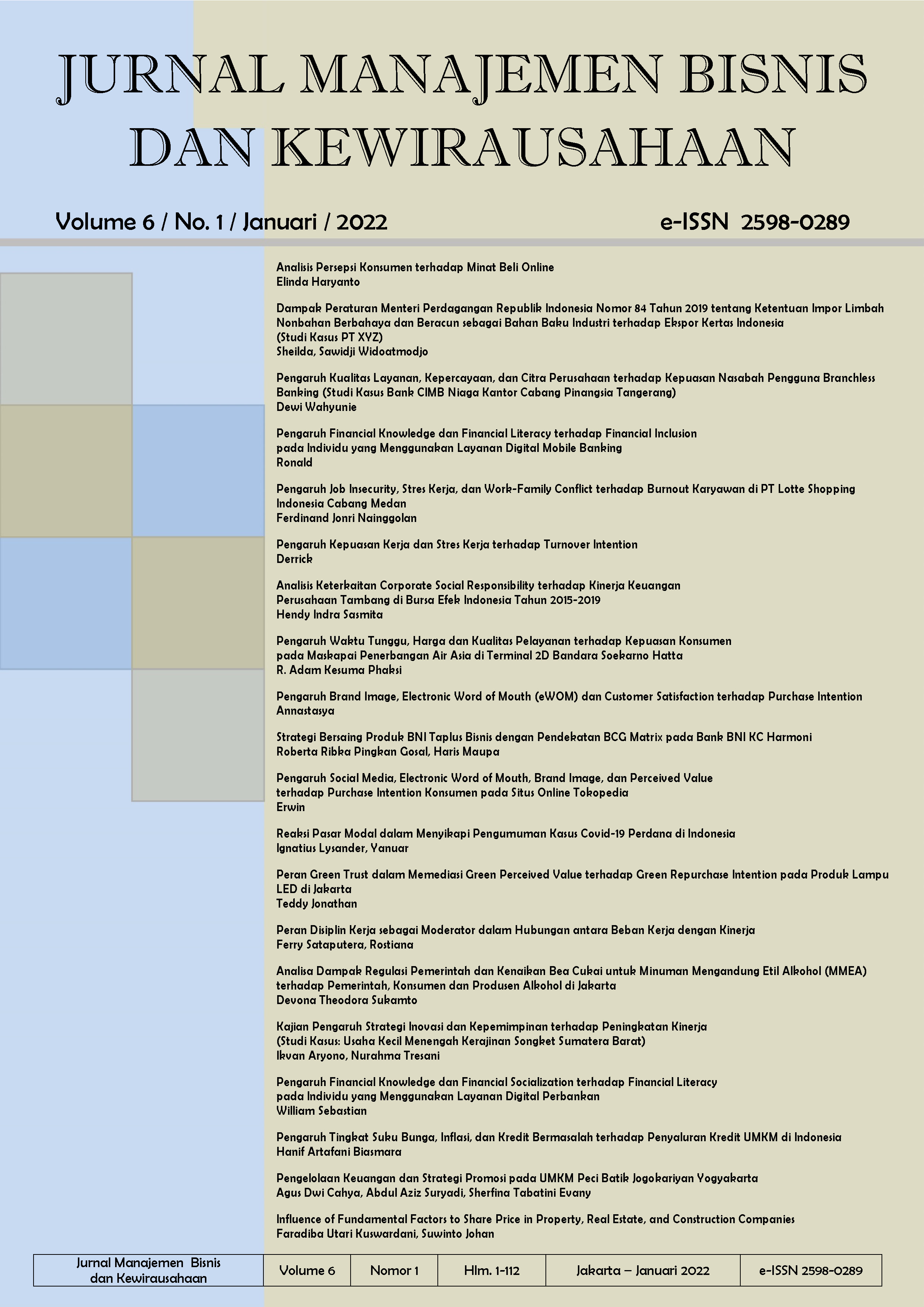Pengaruh Brand Image, Electronic Word of Mouth (eWOM) dan Customer Satisfaction terhadap Purchase Intention
Main Article Content
Abstract
This research wants to show the influence of brand image, electronic word of mouth (eWOM), and customer satisfaction on purchase intention. This descriptive research involved quantitative data collecting using a questionnaire as a data collection method. The researcher used the convenience sampling method to take 123 respondents with valid data. The data analysis technique used Partial Least Square – Structured Equation Modelling (PLS-SEM) with the help of Smart PLS 3.3.2 software. This study concluded that 1) Brand image has an insignificantly positive effect on purchase intention, 2) Customer Satisfaction has a significantly positive effect on purchase intention, 3) eWOM has a significant positive effect on purchase intention.
Penelitian ini dibuat untuk menunjukkan pengaruh brand image, electronic word of mouth (eWOM), dan customer satisfaction terhadap purchase intention. Pada penelitian deskriptif ini menggunakan pengumpulan data kuantitatif dengan kuesioner secara cross-sectional sebagai metode pengumpulan data. Metode yang digunakan adalah convenience sampling dengan sebanyak 123 responden data yang valid. Teknik analisis data menggunakan Partial Least Square – Structured Equation Modelling (PLS-SEM) dengan bantuan software Smart PLS 3.3.2. Kesimpulan pada penelitian ini adalah 1) Brand image berpengaruh positif tidak signifikan terhadap purchase intention, 2) Customer Satisfaction berpengaruh positif signifikan terhadap purchase intention, 3) eWOM berpengaruh positif signifikan terhadap purchase intention.
Article Details
This work is licensed under a Jurnal Manajemen Bisnis dan Kewirausahaan Creative Commons Attribution-ShareAlike 4.0 International License.
References
Abubakar, A. M., & Ilkan, M. (2016). Impact of online WOM on destination trust and intention to travel: A medical tourism perspective. Journal of Destination Marketing and Management, 5(3), 192–201. https://doi.org/10.1016/j.jdmm.2015.12.005
Alwi, S. F. S., & Kitchen, P. J. (2014). Projecting corporate brand image and behavioral response in business schools: Cognitive or affective brand attributes? Journal of Business Research, 67(11), 2324–2336. https://doi.org/10.1016/j.jbusres.2014.06.020
Chae, M., Kim, J., Kim, H., & Ryu, H. (2002). Information quality for mobile internet services: A theoretical model with empirical validation. Electronic Markets, 12(1), 38–46. https://doi.org/10.1080/101967802753433254
Chu, F., & Zhang, X. (2016). Satisfaction, trust and online purchase intention: A study of consumer perceptions. 2016 International Conference on Logistics, Informatics and Service Sciences, LISS 2016. https://doi.org/10.1109/LISS.2016.7854436
de Ruyter, K., & Bloemer, J. (1999). Customer loyalty in extended service settings: The interaction between satisfaction, value attainment and positive mood. International Journal of Service Industry Management, 10(3), 320–336. https://doi.org/10.1108/09564239910276917
Farzin, M., & Fattahi, M. (2018). eWOM through social networking sites and impact on purchase intention and brand image in Iran. Journal of Advances in Management Research, 15(2), 161–183. https://doi.org/10.1108/JAMR-05-2017-0062
Garg, P., & Joshi, R. (2018). Purchase intention of “Halal” brands in India: The mediating effect of attitude. Journal of Islamic Marketing, 9(3), 683–694. https://doi.org/10.1108/JIMA-11-2017-0125
Hakim, L. L., & Keni. (2020). Pengaruh brand awareness, brand image dan customer perceived value terhadap purchase intention. Jurnal Manajemen Bisnis Dan Kewirausahaan, 4(3), 81–86. https://doi.org/10.24912/jmbk.v4i3.7921
Hennig-Thurau, T., Gwinner, K. P., Walsh, G., & Gremler, D. D. (2004). Electronic word-of-mouth via consumer-opinion platforms: What motivates consumers to articulate themselves on the Internet? Journal of Interactive Marketing, 18(1), 38–52. https://doi.org/10.1002/dir.10073
Kotler, P., & Keller, K. L. (2016). Marketing management (15th ed.). Pearson Education, Inc.
Lien, C. H., Wen, M. J., Huang, L. C., & Wu, K. L. (2015). Online hotel booking: The effects of brand image, price, trust and value on purchase intentions. Asia Pacific Management Review, 20(4), 210–218. https://doi.org/10.1016/j.apmrv.2015.03.005
Mortazavi, M., Esfidani, M. R., & Barzoki, A. S. (2014). Influencing VSN users’ purchase intentions: The roles of flow, trust and eWOM. Journal of Research in Interactive Marketing, 8(2), 102–123. https://doi.org/10.1108/JRIM-08-2013-0057
Putri, N., Rachmawati, I., & Prabowo, F. S. A. (2016). Pengaruh electronic word of mouth terhadap brand equity Indomie (Studi pada followers official account jejaring sosial Indomie). E-Proceeding of Management, 3(3), 2976–2984. https://openlibrarypublications.telkomuniversity.ac.id/index.php/management/article/view/2984/2830
Setiawan, B., & Rabuani, C. C. (2019). Pengaruh iklan dan endorser terhadap brand awareness serta dampaknya pada keputusan pembelian. Riset, 1(1), 001–015. https://doi.org/10.35212/277621
Susanto, W. K., & Keni. (2019). Pengaruh social network marketing (SNM) dan electronic word of mouth (eWOM) terhadap minat beli pelanggan. Jurnal Manajemen Bisnis Dan Kewirausahaan, 2(6), 68–73. https://doi.org/10.24912/jmbk.v2i6.4910
Swari, N., & Giantari, I. (2017). Peran kepuasan konsumen memediasi hubungan nilai utilitarian dan nilai hedonik dengan loyalitas konsumen. E-Jurnal Manajemen Universitas Udayana, 6(3), 1194–1220. https://ojs.unud.ac.id/index.php/Manajemen/article/view/26814/17917
Wang, Y., po lo, H., Chi, R., & Yang, Y. (2004). An integrated framework for customer value and customer-relationship-management performance: A customer-based perspective from China. Managing Service Quality: An International Journal, 14(2/3), 169–182. https://doi.org/10.1108/09604520410528590


